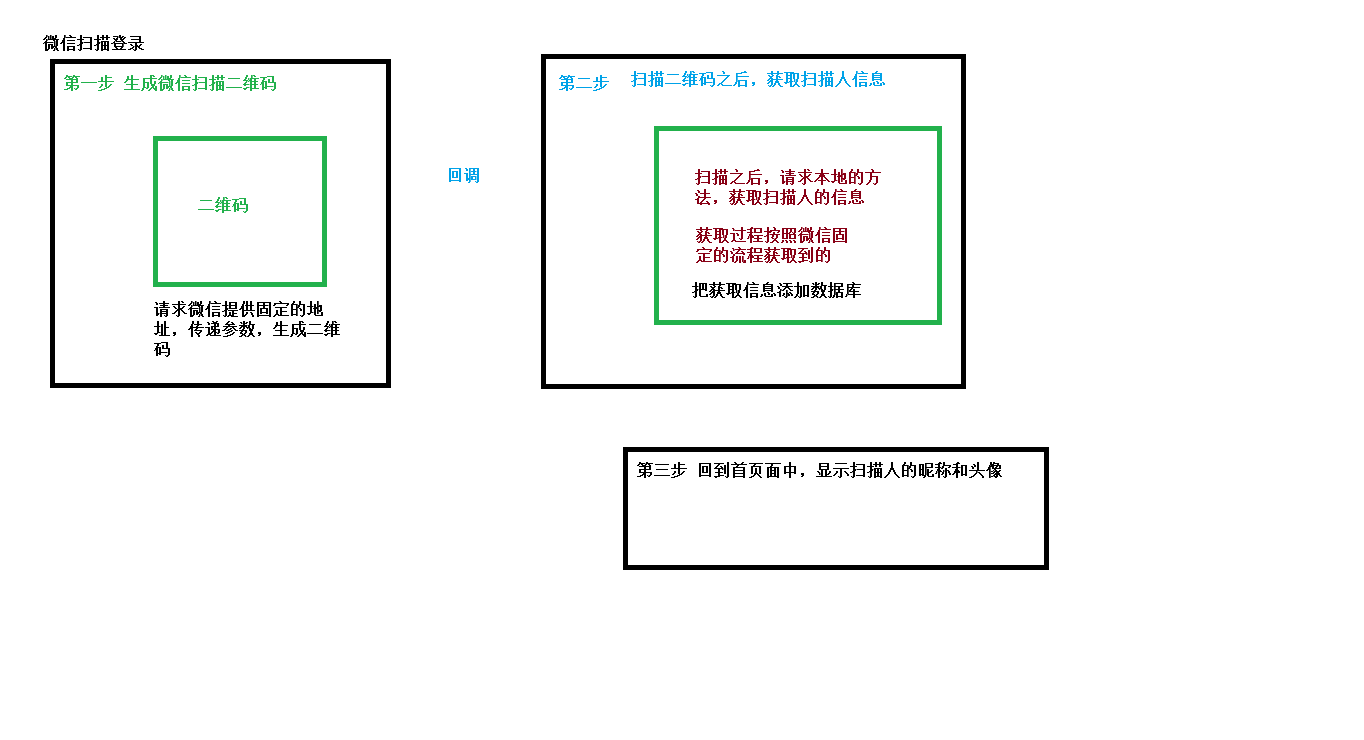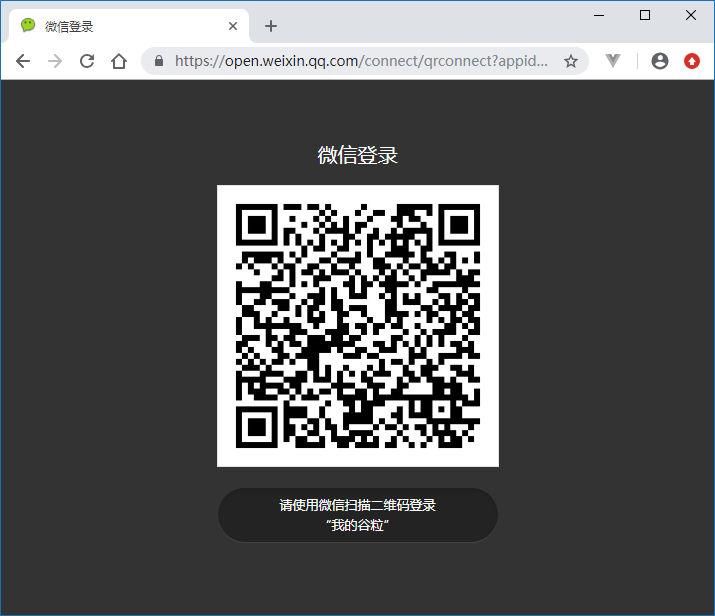微信扫描登录实现
时序图

一、生成二维码页面
生成二维码的主要流程

(1)添加配置
application.properties添加相关配置信息
# 微信开放平台 appid
wx.open.app_id=你的appid
# 微信开放平台 appsecret
wx.open.app_secret=你的appsecret
# 微信开放平台 重定向url
wx.open.redirect_url=http://你的服务器名称/api/ucenter/wx/callback
(2)创建常量类
ConstantPropertiesUtil
@Component
public class ConstantPropertiesUtil implements InitializingBean {
@Value("${wx.open.app_id}")
private String appId;
@Value("${wx.open.app_secret}")
private String appSecret;
@Value("${wx.open.redirect_url}")
private String redirectUrl;
public static String WX_OPEN_APP_ID;
public static String WX_OPEN_APP_SECRET;
public static String WX_OPEN_REDIRECT_URL;
@Override
public void afterPropertiesSet() throws Exception {
WX_OPEN_APP_ID = appId;
WX_OPEN_APP_SECRET = appSecret;
WX_OPEN_REDIRECT_URL = redirectUrl;
}
}
(3)创建Controller
@Controller
@CrossOrigin
@RequestMapping("/api/ucenter/wx")
public class WxApicontroller {
@Autowired
private MemberService memberService;
/**
* 生成二维码
*/
@GetMapping("/login")
public String genQrConnect() {
//请求微信提供的固定地址,向地址中拼接参数,生成二维码
// 微信开放平台授权baseUrl
String baseUrl = "https://open.weixin.qq.com/connect/qrconnect" +
"?appid=%s" +
"&redirect_uri=%s" +
"&response_type=code" +
"&scope=snsapi_login" +
"&state=%s" +
"#wechat_redirect";
try {
//对重定向的地址使用Encode编码
String redirectUrl = ConstantPropertiesUtil.WX_OPEN_REDIRECT_URL;
redirectUrl = URLEncoder.encode(redirectUrl,"utf-8");
String state = "atguan";//使用内网穿透的前置域名,仅仅是在个人测试使用
//在baseurl中拼接参数
String qrcodeUrl = String.format(
baseUrl,
ConstantPropertiesUtil.WX_OPEN_APP_ID,
redirectUrl,
state
);
return "redirect:"+qrcodeUrl;
} catch (UnsupportedEncodingException e) {
e.printStackTrace();
return null;
}
}
}
启动项目,访问网址可以看到二维码页面

根据时序图已经完成

二、获得用户的code(临时票据)
(1)在Controller中加入回调方法
@GetMapping("callback")
public String callback(String code, String state, HttpSession session) {
//得到授权临时票据code
System.out.println("code = " + code);
System.out.println("state = " + state);
}
测试回调方法是否可用
//返回的code
0618nIko0Udctm14zijo0OFQko08nIki
三、通过code加上appid和appsecret换取access_token
(1)加入依赖
<!--httpclient-->
<dependency>
<groupId>org.apache.httpcomponents</groupId>
<artifactId>httpclient</artifactId>
<version>4.5.1</version>
</dependency>
<!--commons-io-->
<dependency>
<groupId>commons-io</groupId>
<artifactId>commons-io</artifactId>
<version>2.6</version>
</dependency>
<!--gson-->
<dependency>
<groupId>com.google.code.gson</groupId>
<artifactId>gson</artifactId>
<version>2.8.2</version>
</dependency>
(2)创建httpClient工具类
public class HttpClientUtils {
public static final int connTimeout=10000;
public static final int readTimeout=10000;
public static final String charset="UTF-8";
private static HttpClient client = null;
static {
PoolingHttpClientConnectionManager cm = new PoolingHttpClientConnectionManager();
cm.setMaxTotal(128);
cm.setDefaultMaxPerRoute(128);
client = HttpClients.custom().setConnectionManager(cm).build();
}
public static String postParameters(String url, String parameterStr) throws ConnectTimeoutException, SocketTimeoutException, Exception{
return post(url,parameterStr,"application/x-www-form-urlencoded",charset,connTimeout,readTimeout);
}
public static String postParameters(String url, String parameterStr,String charset, Integer connTimeout, Integer readTimeout) throws ConnectTimeoutException, SocketTimeoutException, Exception{
return post(url,parameterStr,"application/x-www-form-urlencoded",charset,connTimeout,readTimeout);
}
public static String postParameters(String url, Map<String, String> params) throws ConnectTimeoutException,
SocketTimeoutException, Exception {
return postForm(url, params, null, connTimeout, readTimeout);
}
public static String postParameters(String url, Map<String, String> params, Integer connTimeout,Integer readTimeout) throws ConnectTimeoutException,
SocketTimeoutException, Exception {
return postForm(url, params, null, connTimeout, readTimeout);
}
public static String get(String url) throws Exception {
return get(url, charset, null, null);
}
public static String get(String url, String charset) throws Exception {
return get(url, charset, connTimeout, readTimeout);
}
/**
* 发送一个 Post 请求, 使用指定的字符集编码.
*
* @param url
* @param body RequestBody
* @param mimeType 例如 application/xml "application/x-www-form-urlencoded" a=1&b=2&c=3
* @param charset 编码
* @param connTimeout 建立链接超时时间,毫秒.
* @param readTimeout 响应超时时间,毫秒.
* @return ResponseBody, 使用指定的字符集编码.
* @throws ConnectTimeoutException 建立链接超时异常
* @throws SocketTimeoutException 响应超时
* @throws Exception
*/
public static String post(String url, String body, String mimeType,String charset, Integer connTimeout, Integer readTimeout)
throws ConnectTimeoutException, SocketTimeoutException, Exception {
HttpClient client = null;
HttpPost post = new HttpPost(url);
String result = "";
try {
if (StringUtils.isNotBlank(body)) {
HttpEntity entity = new StringEntity(body, ContentType.create(mimeType, charset));
post.setEntity(entity);
}
// 设置参数
Builder customReqConf = RequestConfig.custom();
if (connTimeout != null) {
customReqConf.setConnectTimeout(connTimeout);
}
if (readTimeout != null) {
customReqConf.setSocketTimeout(readTimeout);
}
post.setConfig(customReqConf.build());
HttpResponse res;
if (url.startsWith("https")) {
// 执行 Https 请求.
client = createSSLInsecureClient();
res = client.execute(post);
} else {
// 执行 Http 请求.
client = HttpClientUtils.client;
res = client.execute(post);
}
result = IOUtils.toString(res.getEntity().getContent(), charset);
} finally {
post.releaseConnection();
if (url.startsWith("https") && client != null&& client instanceof CloseableHttpClient) {
((CloseableHttpClient) client).close();
}
}
return result;
}
/**
* 提交form表单
*
* @param url
* @param params
* @param connTimeout
* @param readTimeout
* @return
* @throws ConnectTimeoutException
* @throws SocketTimeoutException
* @throws Exception
*/
public static String postForm(String url, Map<String, String> params, Map<String, String> headers, Integer connTimeout,Integer readTimeout) throws ConnectTimeoutException,
SocketTimeoutException, Exception {
HttpClient client = null;
HttpPost post = new HttpPost(url);
try {
if (params != null && !params.isEmpty()) {
List<NameValuePair> formParams = new ArrayList<NameValuePair>();
Set<Entry<String, String>> entrySet = params.entrySet();
for (Entry<String, String> entry : entrySet) {
formParams.add(new BasicNameValuePair(entry.getKey(), entry.getValue()));
}
UrlEncodedFormEntity entity = new UrlEncodedFormEntity(formParams, Consts.UTF_8);
post.setEntity(entity);
}
if (headers != null && !headers.isEmpty()) {
for (Entry<String, String> entry : headers.entrySet()) {
post.addHeader(entry.getKey(), entry.getValue());
}
}
// 设置参数
Builder customReqConf = RequestConfig.custom();
if (connTimeout != null) {
customReqConf.setConnectTimeout(connTimeout);
}
if (readTimeout != null) {
customReqConf.setSocketTimeout(readTimeout);
}
post.setConfig(customReqConf.build());
HttpResponse res = null;
if (url.startsWith("https")) {
// 执行 Https 请求.
client = createSSLInsecureClient();
res = client.execute(post);
} else {
// 执行 Http 请求.
client = HttpClientUtils.client;
res = client.execute(post);
}
return IOUtils.toString(res.getEntity().getContent(), "UTF-8");
} finally {
post.releaseConnection();
if (url.startsWith("https") && client != null
&& client instanceof CloseableHttpClient) {
((CloseableHttpClient) client).close();
}
}
}
/**
* 发送一个 GET 请求
*
* @param url
* @param charset
* @param connTimeout 建立链接超时时间,毫秒.
* @param readTimeout 响应超时时间,毫秒.
* @return
* @throws ConnectTimeoutException 建立链接超时
* @throws SocketTimeoutException 响应超时
* @throws Exception
*/
public static String get(String url, String charset, Integer connTimeout,Integer readTimeout)
throws ConnectTimeoutException,SocketTimeoutException, Exception {
HttpClient client = null;
HttpGet get = new HttpGet(url);
String result = "";
try {
// 设置参数
Builder customReqConf = RequestConfig.custom();
if (connTimeout != null) {
customReqConf.setConnectTimeout(connTimeout);
}
if (readTimeout != null) {
customReqConf.setSocketTimeout(readTimeout);
}
get.setConfig(customReqConf.build());
HttpResponse res = null;
if (url.startsWith("https")) {
// 执行 Https 请求.
client = createSSLInsecureClient();
res = client.execute(get);
} else {
// 执行 Http 请求.
client = HttpClientUtils.client;
res = client.execute(get);
}
result = IOUtils.toString(res.getEntity().getContent(), charset);
} finally {
get.releaseConnection();
if (url.startsWith("https") && client != null && client instanceof CloseableHttpClient) {
((CloseableHttpClient) client).close();
}
}
return result;
}
/**
* 从 response 里获取 charset
*
* @param ressponse
* @return
*/
@SuppressWarnings("unused")
private static String getCharsetFromResponse(HttpResponse ressponse) {
// Content-Type:text/html; charset=GBK
if (ressponse.getEntity() != null && ressponse.getEntity().getContentType() != null && ressponse.getEntity().getContentType().getValue() != null) {
String contentType = ressponse.getEntity().getContentType().getValue();
if (contentType.contains("charset=")) {
return contentType.substring(contentType.indexOf("charset=") + 8);
}
}
return null;
}
/**
* 创建 SSL连接
* @return
* @throws GeneralSecurityException
*/
private static CloseableHttpClient createSSLInsecureClient() throws GeneralSecurityException {
try {
SSLContext sslContext = new SSLContextBuilder().loadTrustMaterial(null, new TrustStrategy() {
public boolean isTrusted(X509Certificate[] chain,String authType) throws CertificateException {
return true;
}
}).build();
SSLConnectionSocketFactory sslsf = new SSLConnectionSocketFactory(sslContext, new X509HostnameVerifier() {
@Override
public boolean verify(String arg0, SSLSession arg1) {
return true;
}
@Override
public void verify(String host, SSLSocket ssl)
throws IOException {
}
@Override
public void verify(String host, X509Certificate cert)
throws SSLException {
}
@Override
public void verify(String host, String[] cns,
String[] subjectAlts) throws SSLException {
}
});
return HttpClients.custom().setSSLSocketFactory(sslsf).build();
} catch (GeneralSecurityException e) {
throw e;
}
}
public static void main(String[] args) {
try {
String str= post("https://localhost:443/ssl/test.shtml","name=12&page=34","application/x-www-form-urlencoded", "UTF-8", 10000, 10000);
//String str= get("https://localhost:443/ssl/test.shtml?name=12&page=34","GBK");
/*Map<String,String> map = new HashMap<String,String>();
map.put("name", "111");
map.put("page", "222");
String str= postForm("https://localhost:443/ssl/test.shtml",map,null, 10000, 10000);*/
System.out.println(str);
} catch (ConnectTimeoutException e) {
// TODO Auto-generated catch block
e.printStackTrace();
} catch (SocketTimeoutException e) {
// TODO Auto-generated catch block
e.printStackTrace();
} catch (Exception e) {
// TODO Auto-generated catch block
e.printStackTrace();
}
}
}
(3)在Controller中的callback方法中添加
//返回临时票据code
//拿着code请求微信的固定地址
String baseAccessTokenUrl = "https://api.weixin.qq.com/sns/oauth2/access_token" +
"?appid=%s" +
"&secret=%s" +
"&code=%s" +
"&grant_type=authorization_code";
//设置其中的参数
baseAccessTokenUrl = String.format(
baseAccessTokenUrl,
ConstantPropertiesUtil.WX_OPEN_APP_ID,
ConstantPropertiesUtil.WX_OPEN_APP_SECRET,
code
);
try {
//使用httpclient发送请求,获取openid和access_token
String resultAccessToken = HttpClientUtils.get(baseAccessTokenUrl);
System.err.println(resultAccessToken);
//将返回的字符串转化为map对象
Gson gson = new Gson();
Map<String,Object> map = gson.fromJson(resultAccessToken, HashMap.class);
//获取凭证和id
String access_token = (String) map.get("access_token");
String openid = (String) map.get("openid");
} catch (Exception e) {
e.printStackTrace();
return null;
}
此时已经获取到用户的openid以及access_token
其中得到的resultAccessToken为
{
"access_token": "35_V_frEupCU8nXXdTHVjX1rFZois8ph6WrSqtTFQ6u_f-J-JYJvjpDwLPjwULgXhUNe_IgCgH4lmFq9L6ucuZAJ-fbRy64v7WgWIhJlCUihg0",
"expires_in": 7200,
"refresh_token": "35_3De8UjudLa6GmHexFPu4ZpK2Vj5l6eJfXJWC9OyFfYaTWe9XwpBA4dJj9N9xzkQamYmHcpJCspeWoB5wVadpec03HJlPzYdlzRPzx_goEwA",
"openid": "o3_SC5-FiweooMVZNwNPsFwT5JS0",
"scope": "snsapi_login",
"unionid": "oWgGz1E6yQhKUIGSLzRUetlKLLzw"
}
再次参考时序图已经完成

四、获取用户信息

(1)通过openid以及access_token可以请求微信的地址
完善callback方法
Member member = memberService.getOpenUserInfo(openid);
//如果为空,用户不存在,注册
if (member == null) {
//访问微信的资源服务器,获取用户信息
String baseUserInfoUrl = "https://api.weixin.qq.com/sns/userinfo" +
"?access_token=%s" +
"&openid=%s";
baseUserInfoUrl = String.format(
baseUserInfoUrl,
access_token,
openid
);
String resultUserInfo = HttpClientUtils.get(baseUserInfoUrl);
System.err.println(resultUserInfo);
Map<String,Object> userMap = gson.fromJson(resultUserInfo,HashMap.class);
//得到用户的nickname
String nickname =(String) userMap.get("nickname");
//得到用户的头像
String headimgurl = (String) userMap.get("headimgurl");
//添加
Member member1 = new Member();
member1.setNickname(nickname);
member1.setAvatar(headimgurl);
member1.setOpenid(openid);
memberService.save(member1);
}
业务实现:MemberServiceImpl.java
@Override
public Member getOpenUserInfo(String openid) {
QueryWrapper<Member> queryWrapper = new QueryWrapper<>();
queryWrapper.eq("openid", openid);
Member member = baseMapper.selectOne(queryWrapper);
return member;
}
五、使用JWT进行跨域身份验证
(1)加入jwt工具依赖
<!-- JWT -->
<dependency>
<groupId>io.jsonwebtoken</groupId>
<artifactId>jjwt</artifactId>
<version>0.7.0</version>
</dependency>
(2)创建JWT工具类
public class JwtUtils {
public static final String SUBJECT = "guli";
//秘钥
public static final String APPSECRET = "guli";
//生成jwt字符串的过期时间,毫秒,30分钟
public static final long EXPIRE = 1000 * 60 * 30;
/**
* 生成jwt token
*
* @param member
* @return
*/
public static String geneJsonWebToken(Member member) {
if (member == null || StringUtils.isEmpty(member.getId())
|| StringUtils.isEmpty(member.getNickname())
|| StringUtils.isEmpty(member.getAvatar())) {
return null;
}
String token = Jwts.builder().setSubject(SUBJECT)
.claim("id", member.getId())
.claim("nickname", member.getNickname())
.claim("avatar", member.getAvatar())
.setIssuedAt(new Date())
.setExpiration(new Date(System.currentTimeMillis() + EXPIRE))
.signWith(SignatureAlgorithm.HS256, APPSECRET).compact();
return token;
}
/**
* 校验jwt token
*
* @param token
* @return
*/
public static Claims checkJWT(String token) {
Claims claims = Jwts.parser().setSigningKey(APPSECRET).parseClaimsJws(token).getBody();
return claims;
}
//测试生成jwt token
private static String testGeneJwt(){
Member member = new Member();
member.setId("999");
member.setAvatar("www.guli.com");
member.setNickname("Helen");
String token = JwtUtils.geneJsonWebToken(member);
System.out.println(token);
return token;
}
//测试校验jwt token
private static void testCheck(String token){
Claims claims = JwtUtils.checkJWT(token);
String nickname = (String)claims.get("nickname");
String avatar = (String)claims.get("avatar");
String id = (String)claims.get("id");
System.out.println(nickname);
System.out.println(avatar);
System.out.println(id);
}
//测试用例
public static void main(String[] args){
Member member = new Member();
member.setId("11");
member.setNickname("lucy");
member.setAvatar("abcd");
String token = geneJsonWebToken(member);
System.err.println(token);
Claims claims = checkJWT(token);
String id = (String) claims.get("id");
String nickname = (String) claims.get("nickname");
String avatar = (String) claims.get("avatar");
System.err.println(id);
System.err.println(nickname);
System.err.println(avatar);
}
}
(3)继续完善callback方法
if (member == null) {
//访问微信的资源服务器,获取用户信息
String baseUserInfoUrl = "https://api.weixin.qq.com/sns/userinfo" +
"?access_token=%s" +
"&openid=%s";
baseUserInfoUrl = String.format(
baseUserInfoUrl,
access_token,
openid
);
String resultUserInfo = HttpClientUtils.get(baseUserInfoUrl);
System.err.println(resultUserInfo);
Map<String,Object> userMap = gson.fromJson(resultUserInfo,HashMap.class);
String nickname =(String) userMap.get("nickname");
String headimgurl = (String) userMap.get("headimgurl");
//添加
Member member1 = new Member();
member1.setNickname(nickname);
member1.setAvatar(headimgurl);
member1.setOpenid(openid);
memberService.save(member1);
}
//根据member生成jwt字符串
String token = JwtUtils.geneJsonWebToken(member);
//回到首页面
return "redirect:http://localhost:3000?token="+token;
} catch (Exception e) {
e.printStackTrace();
return null;
}
(4)根据token获得用户信息
/**
* 根据token值获取用户信息
*/
@PostMapping("/getUserInfoToken/{token}")
public Result getUserInfoToken(@PathVariable("token") String token) {
Claims claims = JwtUtils.checkJWT(token);
String id = (String) claims.get("id");
String nickname = (String) claims.get("nickname");
String avatar = (String) claims.get("avatar");
Member member = new Member();
member.setAvatar(avatar);
member.setNickname(nickname);
member.setId(id);
return Result.ok().data("member",member);
}




评论区